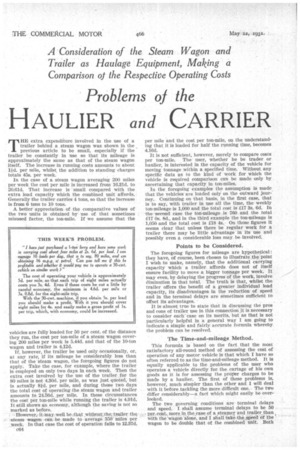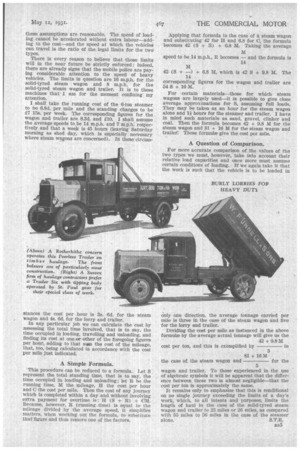Problems of the
Page 134

Page 135

If you've noticed an error in this article please click here to report it so we can fix it.
HAULIER and CARRIER THE extra expenditure involved in the use of a trailer behind a steam wagon was shown in the previous article to be small, especially if the trailer be constantly in use so that its mileage is approximately the same as that of the steam wagon itself. The increase in running costs amounts to about lid. per mile, whilst the addition to standing charges
totals 45s. per week. .
In the case of a steam wagon averaging 200 miles per week the cost per mile is increased from 16.31d. to 20.61d. That increase is small compared with the extra load capacity which the combined unit affords. Generally the trailer carries 4 tons, so that the increase is from 6 tons to 10 tons.
A better appreciation of the comparative values of the two units is obtained by use of that sometimes misused factor, the ton-mile. If we assume that the vehicles are fully loaded for 50 per cent. of the distance they run, the cost per ton-mile of a steam wagon covering 200 miles per week is 5.44d. and that of the 10-ton wagon and trailer is 4.12d.
If, however, the trailer be used only occasionally, or, at any rate, if its mileage be considerably less than that of the steam wagon, the foregoing figures do not apply. Take the case, for example, where the trailer is employed on only two days in each week. Then the extra cost involved by the use of the trailer for the 80 miles is not 4.30d. per mile, as was just quoted, but is actually 81d. per mile, and during those two days the total cost of operating the steam wagon and trailer amounts to 24.56d. per mile. In these circumstances the cost per, ton-mile while running the trailer is 4.91d. It still shows an economy, although the saving is not so marked as before.
However, it-may well be that wititoutr the;trailer the. ,steamwagon can be made to average 350" 'miles per week. In that case the cost of operation falls to 12.37d.
c64 per mile and the cost per ton-mile, on the understanding that it is loaded for half the running time, becomes 4.16d.
It is not sufficient, however, merely to compare costs per ton-mile. The user, whether he be trader or haulier, is interested In the capacity of the vehicle for moving tonnage .within a specified time. Without any specific data as to the kind of work for which the vehicle is required comparison can be made only by ascertaining that capacity in ton-miles.
In the foregoing examples the assumption is made that the vehicles are loaded only on the outward journey. Continuing on that basis, in the first case, that is to say, with trailer in use all the time, the weekly ton-mileage is 1,000 and the total cost is 117 3s. 6d. In the second case the ton-mileage is 760 and the total £17 Os. 8d., and in the third example the ton-mileage is 1,050 and the total cost is 118 4s. On those figures it seems clear that unless there be regular work for a trailer there may be little advantage in its use and possibly even a considerable loss may be involved.
Points to be Considered.
The foregoing figures for mileage are hypothetical: they have, of course, been chosen to illustrate the point I wish to make, namely, that the additional carrying capacity which a trailer affords does not of itself ensure facility to move a bigger tonnage per week. It may even, by delaying the progress of the work, involve diminution in that total. The truth is that, whilst the trailer offers the benefit of a greater individual load capacity, its disadvantages in the reduction of speed and in the terminal delays are sometimes sufficient to offset its advantages.
It is almost true to state that in discussing the pros and cons of trailer use in this connection Lt is necessary to consider each' case on its merits, but as that is not particularly helpful in a general way I am going to indicate a simple and fairly accurate formula whereby the problem can be resolved.
The Time-and-mileage Method.
This formula is based on the fact that the most satisfactory all-round method of assessing the cost of operation of any motor vehicle is that which I have so often referred to as the time-and-mileage method. It is equally applicable to the problems of the user who operates a vehicle directly for the cartage of his own goods as it is for assessing the proper charges to be made by a haulier. The first of these problems is, however, much simpler than the other and I will deal with it before tackling the more difficult one. The two differ considerably—a fact which might easily be overlooked.
The two governing conditions are terminal delays and speed. I shall assume terminal delays to be 50 pqr,cent.rmore in the case of a steamer and trailer than
with the wagon alone, and I shall take the speed Of 'the wagon to be double that of the combined unit. Both these assumptions are reasonable, The speed of loading cannot be accelerated without extra labour—adding to the cost—and the speed at which the vehicles can travel is the ratio of the legal limits for the two types.
There is every reason to believe that those limits will in the near future be strictly enforced : indeed, there are already signs that the mobile police are paying considerable attention to the speed of heavy vehicles. The limits in question are 16 m.p.h. for the solid-tyred steam wagon and 8 m.p.h. for the solid-tyred steam wagon and trailer. It is to these machines that I am for the moment confining my attention.
I shall take the running cost of the 6-ton steamer to be 6.8d. per mile and the standing charges to be £7 15s. per week. The corresponding figures for the wagon and trailer are 8.3d. and £10. I shall assume the average speeds to be 14 m.p.h. and 7 m.p.h. respectively and that a week is 45 hours (leaving Saturday morning as shed day, which is especially necessary where steam wagons are concerned). In these circum
stances the cost per hour is 3s. 6d. for the steam wagon and 4s. 6d. for the lorry and trailer.
In any particular job we can calculate the cost by assessing the total time involved, that is to say, the time• occupied in loading, travelling and unloading, and finding its cost at one or other of the foregoing figures per hour, adding to that nun the cost of the mileage, that, too, being calculated in accordance with the cost per mile just indicated.
A Simple Formula.
This procedure can be reduced to a formula. Let S represent the total standing time, that is to say, the time occupied in loading and unloading; let It be the running time, M the mileage, H the cost per hour and C the cost per mile. Then the cost of any journey which is completed within a day and without involving extra payment for overtime is : H (S + + CM. Because, however, It (running.thne) is equal to the mileage divided by the average speed, it simplifies matters, when working out the formula, to substitute that'figure and thus remove one of the factors.
Applying that formula to the case of a steam wagon and substituting 42 for H and 6.8 for C, the formula becomes 42 (S + R) + 6.8 M. Taking the average speed to be 14 m.p.h., R becomes — and the formula is 14 42 (S + —) + 6.8 M, which is 42 S + 9.8 M. The 14
corresponding figures for the wagon and trailer are 54 S + 16 M.
For ,certain materials—those for which steam wagons are largely used—it is possible to give close average approximations for S, assuming full loads. They may be taken as an hour for the steam wagon alone and 1i hours for the steamer and trailer. I have in mind such materials as sand, gravel, clinker and coal. Then the formula becomes 42 + 9.8 M for the steam wagon and 81 + 16 111 for the steam wagon and trailer: These formulm give the cost per mile.
A Question of Comparison.
For more accurate comparison of the values of the two types we must, however, take into account their relative load capacities and once more must assume certain conditions of loading. If we again take it that the work is such that the vehicle is to be loaded in only one direction, the average tonnage carried per mile is three in the case of the steam wagon and five for the lorry and trailer.
Dividing the cost per mile as instanced in the above formuhe by the average actual tonnage will give us the 42 + 9.8 M cost per ton, and this is exemplified by in 381 + 16M the case of the steam wagon and for the 5
wagon and trailer. To those experienced in the use of algebraic symbols it will be apparent that the difference between these two is almost negligible—that the cost per ton is approximately the same. It remains only to emphasize that this is conditional on no single journey exceeding the limits of a day's work, which, to all intents and purposes, limits the length of haul in the case of the solid-tyred steam wagon and trailer to 25 miles or 26 miles, as compared with 65 miles to 56 miles in the case of the steamer
alone. S.T.R.




































































































































































































